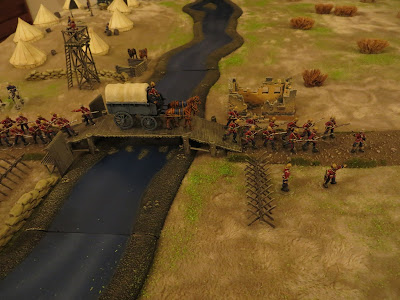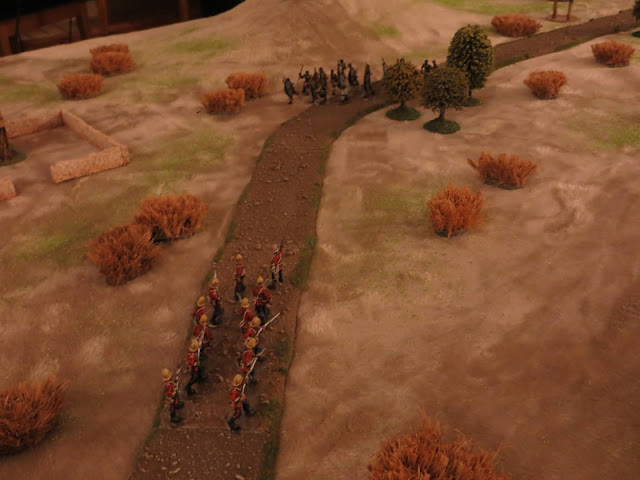Sono sempre stato affascinato dal periodo coloniale vittoriano e, in questo momento in cui mi sento inusitatamente veloce e prolifico nella pittura, ho approfittato per una rapida digressione nel periodo.
Ho scelto pezzi della Hat, la quale per le guerre Zulu e per il Sudan ha una gamma piuttosto completa e sufficientemente ben realizzata, pure con le inevitabili limitazioni che la plastica morbida impone. Gli elementi scenici che vedrete nelle foto sono in massima parte Italeri (ponte, torretta e varie) e Renedra (tende, che a sentire loro sarebbero in 28mm ma che secondo me per il 20mm sono molto più proporzionate):
 |
| Panoramica del terreno, con il campo britannico e la selvaggia terra Zulu oltre il fiume! |
 |
| Le tende Renedra per i 28mm (!) |
 |
| Torretta e postazione Italeri, sacchi di sabbia Renedra |
Circa il regolamento, dopo qualche ricerca su internet ho optato per "The men who would be kings", sritto da Daniel Mersey e pubblicato nel 2016 dalla Osprey, ed è soprattutto di questo che vorrei parlare qui. Premetto che ho letto il testo con grande attenzione e che mi sono anche preparato delle tabelle personalizzate (sia tabelle di gioco che liste esercito), ma ho giocato solo un inizio di partita (comprensivo di fuoco e mischia), giusto per verificare il mio grado di apprendimento e provare il funzionamento del sistema.
E' un regolamento semi - skirmish: i pezzi sono imbasettati singolarmente, ma nel gioco sono raggruppati in unità, di consistenza che potremmo definire media (una unità di fanteria regolare è composta da 12 soldatini, una di fanteria tribale da 16, una di cavalleria regolare da 8, eccetera).
Sono numeri suggeriti, ovviamente, ma rappresentano a mio giudizio un buon compromesso (leggermente verso l’alto) tra quantità di pezzi necessari e impatto scenico.
E' comunque previsto dallo stesso autore che si possa giocare anche con la metà degli effettivi, per partite molto veloci.
Le truppe disponibili sono suddivise in poche categorie, rappresentative di ciò che si poteva trovare sul campo in Sudan, in Sudafrica, in Cina o nei molti altri teatri coloniali: fanteria e cavalleria sono distinte in regolare, irregolare o tribale, poi sono previste armi con serventi (cannoni da campo o Gatling).
Ciascuna unità è caratterizzata da fattori che più classici non si può: movimento, fuoco, mischia, disciplina, armamento, più alcune caratteristiche tipiche (ad esempio, la fanteria regolare può assumere l'ordine chiuso e sparare all'unisono).
Le unità costano, di base, dai 3 ai 6 punti, a seconda del tipo, e una forza è normalmente composta da 24 punti (quindi sul tavolo avremo idealmente dalle 4 alle 8 unità per parte).
Ogni unità deve avere un comandante, la cui caratterizzazione rappresenta uno dei pochi veri elementi di originalità del regolamento: all'inizio del gioco, si devono lanciare dei dadi per definire i tratti di ogni leader; non solo la sua capacità di comando (molto buona, buona, normale o scarsa), ma anche per definire un ulteriore tratto saliente del suo carattere (ce ne sono di divertenti, come “ubriacone”, “idiota”, “ansioso” e una miriade di altri, talvolta definiti con colorite espressioni idiomatiche “british”!).
Le capacità complessive del comandante hanno importanti riflessi nel gioco, perché consentono alle unità di attivarsi più o meno agevolmente e di perdere o recuperare più o meno bene la capacità combattiva dopo aver ricevuto perdite.
E’ interessante sottolineare che l’attribuzione delle capacità a un leader è del tutto casuale, quindi potremo avere la nostra migliore unità comandata da un perfetto incapace!
Questa commistione tra capacità tecnica dell’unità e tratto umano del comandante mi pare uno spunto molto brillante del regolamento e, probabilmente, anche molto aderente al clima del periodo, in cui a quanto pare il grado di addestramento e di esperienza degli ufficiali potevano essere tutt’altro che omogenei e scontati!
Stabilita l’iniziativa in modo casuale (con qualche aggiustamento negli scenari proposti), il primo giocatore fa agire le sue unità, ciascuna delle quali deve compiere una delle seguenti azioni possibili: stare ferma, muovere, muovere veloce, muovere e sparare, attaccare, fare fuoco, recuperare, andare a terra (solo fanterie tribali), mettersi in ordine chiuso (solo le fanterie regolari).
Molti di questi ordini possono essere eseguiti dall’unità solo se il suo comandante passa un test di leadership; tale dato varia a seconda del tipo delle unità, il che contribuisce a caratterizzarle (ad esempio, la fanteria regolare può fare fuoco senza bisogno del test, né ha bisogno del test la fanteria tribale per muovere, ecc.).
Ciò detto, lo svolgimento del gioco è di una semplicità estrema ed è l’autore stesso a suggerire molta elasticità nel calcolo dei movimenti o nel valutare gli effetti del terreno (per i quali sono comunque fornite regole molto semplici, pratiche e intelligenti).
Quando una unità fa fuoco o si impegna in mischia, lancia di solito tanti dadi quanti sono i suoi uomini e ogni volta che eguaglia o supera i suoi valori relativi (ad es. 5+ nel fuoco) mette a segno un colpo.
I colpi che servono per neutralizzare un soldato nemico sono generalmente uno, ma in taluni casi due o anche più (fanti contro cavalieri, tiro a lungo raggio, coperture varie).
Nelle mischie, chi sostiene più perdite è sconfitto e deve ritirarsi di metà movimento.
Inoltre, chi è sconfitto in mischia o riceve perdite dal fuoco deve sottoporsi a un test per vedere se rimane bloccato (pinned).
Unità bloccate non possono intraprendere azioni finché non superano il relativo test di riordino.
Perdite subite, “pin” accumulati, disciplina dell’unità agiscono in vario modo in questi test (“pinning test” e “rally test”), il cui obiettivo è sempre quello di raggiungere o superare la leadership del comandante dell’unità che lo sostiene.
Questo, in breve, è il gioco.
Regole, come vedete, di una semplicità quasi disarmante, che dovrebbero garantire partite rapide e molto movimentate, senza fasi di stallo, calcoli complicati e appesantimenti vari, circostanza confermata (per il momento) dalla rapida prova che ho fatto.
Il regolamento comprende anche regole opzionali, 30 liste esercito a 24 punti, 8 scenari (che l’autore raccomanda caldamente di utilizzare, pure non escludendo che si possano giocare partite libere “all’ultimo sangue”).
Una peculiarità su cui vorrei, in ultimo, soffermarmi è la presenza di un capitolo (il quinto), intitolato “Giocare contro Mr. Babbage”: Charles Babbage fu un importante scienziato inglese dell’epoca vittoriana, cui viene fatta risalire la progettazione e la messa in opera dei primi calcolatori, e il capitolo in questione null’altro è che un sistema di attivazione “automatica” dell’avversario in modo da poter giocare in solitario contro orde di guerrieri Zulu che compaiono dal nulla (o anche il contrario, cioè in solitario contro gli “imperialist dogs”!).
Tirando le somme, mi pare un buon regolamento, semplice, divertente e completo (oltre il volumetto della Osprey, che costa poco, per giocare non c’è bisogno di altro, anche se la pagina di “pronto riferimento” è davvero insufficiente e vale la pena di rifarla in proprio, magari in italiano).
Non vi aspettate però fedeltà storica assoluta e realismo spinto, perché se cercate questo non è il prodotto che fa per voi: qua si va per “macro - categorie” tutto si sacrifica in nome del dinamismo dell’azione di gioco e del divertimento.
Poiché il periodo storico in questione è molto suggestivo (e sono sicuro che molti di noi si orientano su queste ambientazioni più per il fascino che per le tematiche tattiche, in realtà mediocri), non sarà inutile far presente che il regolamento, oltre a essere chiaro, è scritto in modo scorrevole e divertente, con simpatici riferimenti al clima dell’epoca e con una sempre percepibile aleggiante presenza del romanzo (e film) forse più evocativo al riguardo: “L’uomo che volle farsi re”, romanzo di Kipling portato nelle sale cinematografiche con l’omonimo film del 1975 di John Huston, interpretato dai britannicissimi Sean Connery e Michael Caine
Qualche scatto dalla prima, rapidissima esperienza di gioco (applicando le regole di "Mr. Babbage"):
 |
| Due squadre si apprestano a lasciare il campo, con il compito di stare fuori qualche giorno ed esplorare il territorio circostante; il Comandante assiste all'uscita dei suoi uomini. |
 |
| Il Comandante (in giacca blu) e il suo più fido collaboratore (figure Hat, cavallo bianco Italeri) |
 |
| Squadra del 24th Foot, comandata dal Ltn. Bromhead (buon comandante, ma codardo in azione) |
 |
| Squadra del 90th Light infantry, dal Sgt. Melvill (buon comandante e affidabile) |
 |
Il distaccamento esce dal campo, sotto lo sguardo dubbioso delle sentinelle |
 |
| Si entra in territorio ostile! |
 |
Visti i suoi uomini uscire, il Comandante torna al campo per una tazza di tè! |
 |
| Il loro leader, Dingiswayo, è un bravo guerriero, e li spinge subito all'assalto! |
 |
| La prima squadra del 24th, presa alla sprovvista, non fa in tempo a schierarsi e fare fuoco ed è costretta a un feroce corpo a corpo! |
 |
| La squadra del 90th avanza in linea per dare aiuto |
 |
| Il combattimento infuria |
 |
| Gli uomini del 24th sono costretti ad arretrare, con forti perdite |
 |
| Il 90th avanza e fa fuoco, ma senza grossi risultati |
 |
| Il 90th subisce a sua volta una carica, ma riesce a resistere e gli Zulu devono arretrare |
 |
| Il fuoco concentrato dei pochi superstiti del 24th e dei poco più numerosi soldati del 90th riesce infine ad avere ragione dell'unità Zulu |
 |
| Ma lo scontro è stato assai cruento, e anche gli inglesi, all'appello, contano gravi perdite |
 |
| I superstiti si chiedono se sia il caso di andare avanti o se sia meglio tornare al campo! Quanto appena avvenuto è solo un aperitivo di ciò che potrà accadere loro contro le lance Zulu ... |































